Abstract
Passive protection of neonatal piglets against fatal enteric colibacillosis was achieved with powder preparations of specific antibodies against K88, K99, and 987P fimbrial adhesins of enterotoxigenic Escherichia coli. The antibody powders were obtained by spray drying the water-soluble protein fraction of egg yolks from immunized hens after the lipid components were precipitated with an aqueous dispersion of acrylic resins (Eudragit L30D-55; Rohm pharma). The anti-K88, -K99, and -987P antibody preparations reacted specifically against the corresponding fimbrial antigens in an enzyme-linked immunosorbent assay. The orally administered antibodies protected in a dose-dependent fashion against infection with each of the three homologous strains of E. coli in passive immunization trials with a colostrum-deprived piglet model of enterotoxigenic E. coli diarrhea. Scanning electron microscopy revealed adherence of enterotoxigenic E. coli in intestinal epithelial surfaces of control piglets, whereas in treated piglets treated with high-titer antibodies, a resistance to bacterial adhesion was observed. An enzyme immunoassay with avidin-biotin complex demonstrated specific local antibody activity in target areas of the small intestines. In vitro, E. coli K88+, K99+, and 987P+ strains adhered equally to porcine duodenal and ileal epithelial cells but failed to do so in the presence of homologous anti-fimbrial antibodies. Absorption of egg yolk antibodies with fimbrial immunosorbent removed the anti-fimbrial antibody fraction and reduced significantly the protective nature of the antibody preparation in a passive immunization experiment, suggesting that anti-fimbrial antibodies were the active components.
Full text
PDF
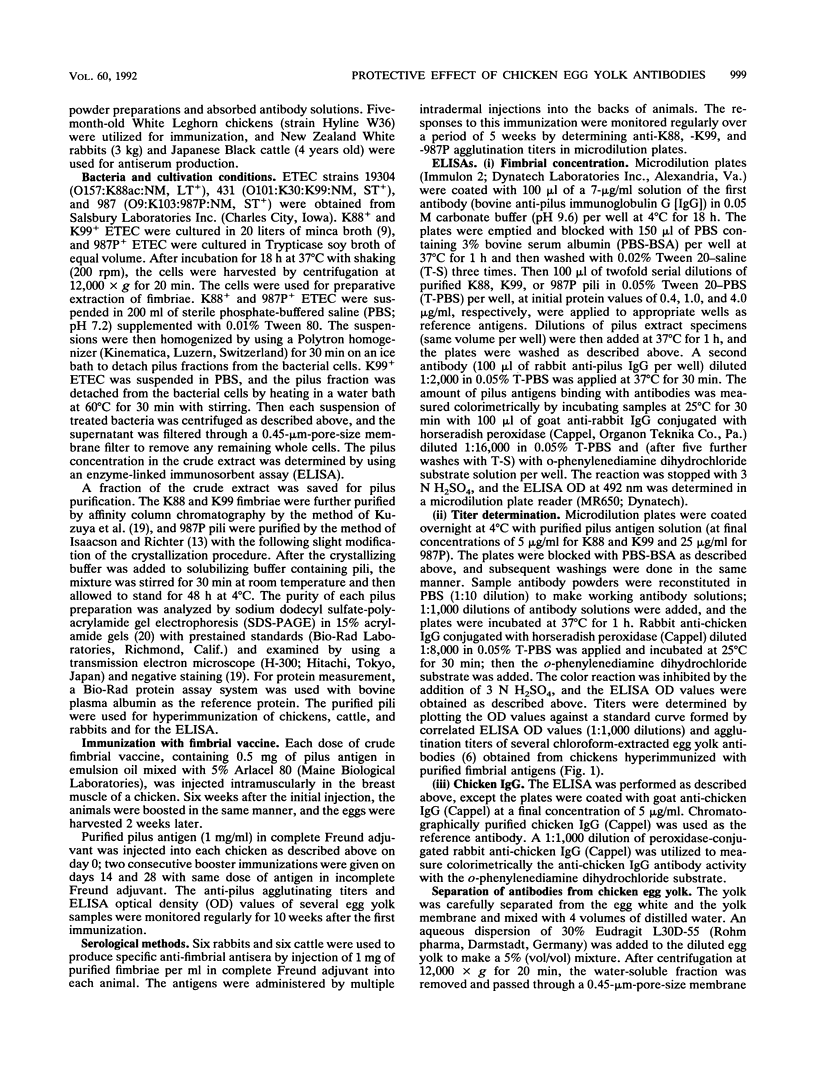
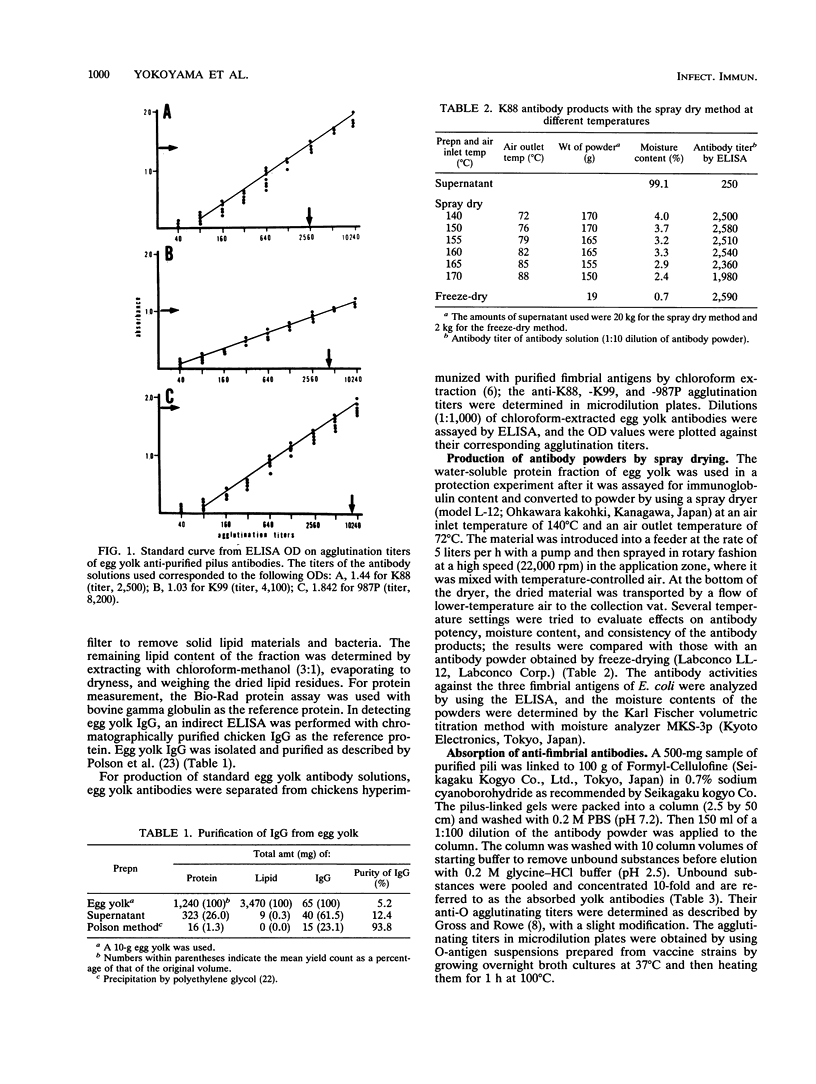

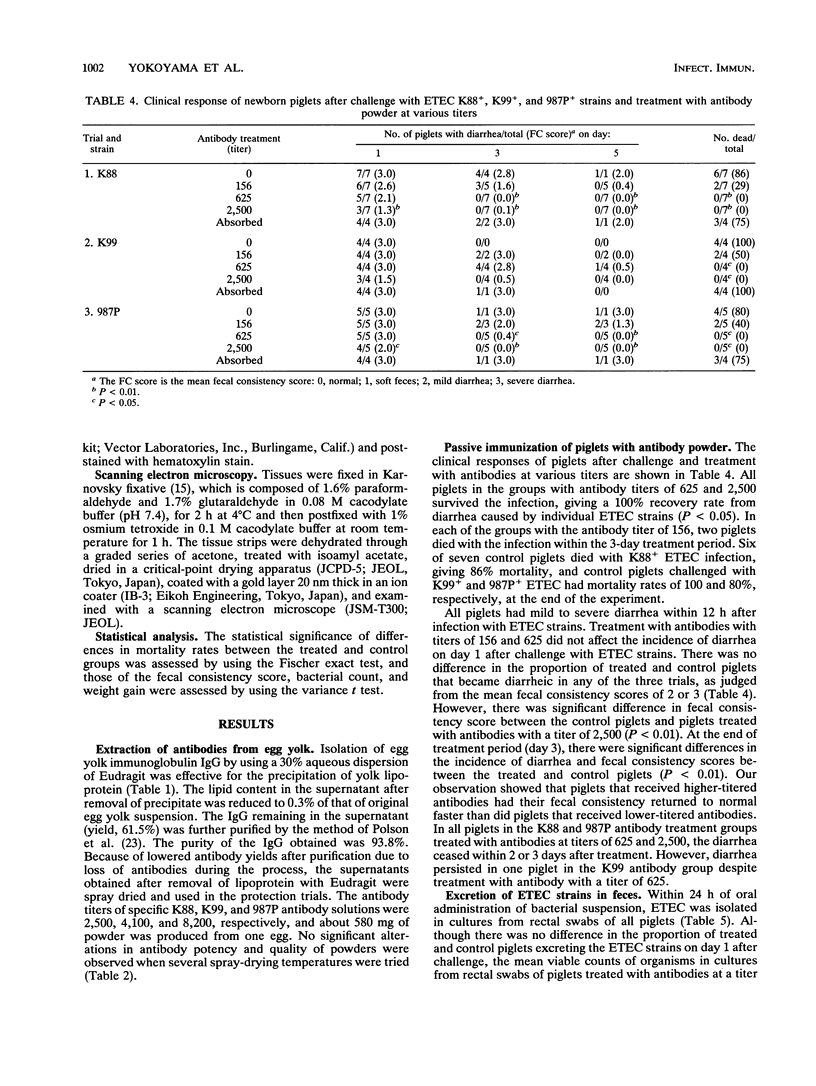
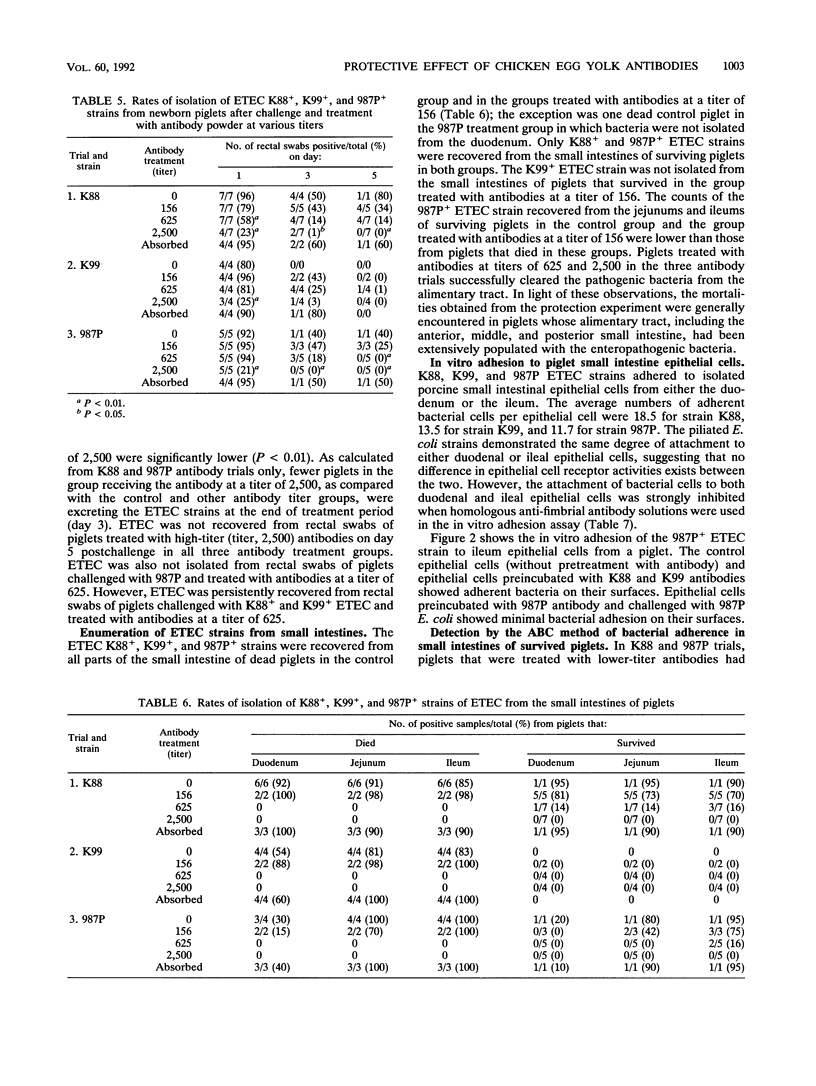
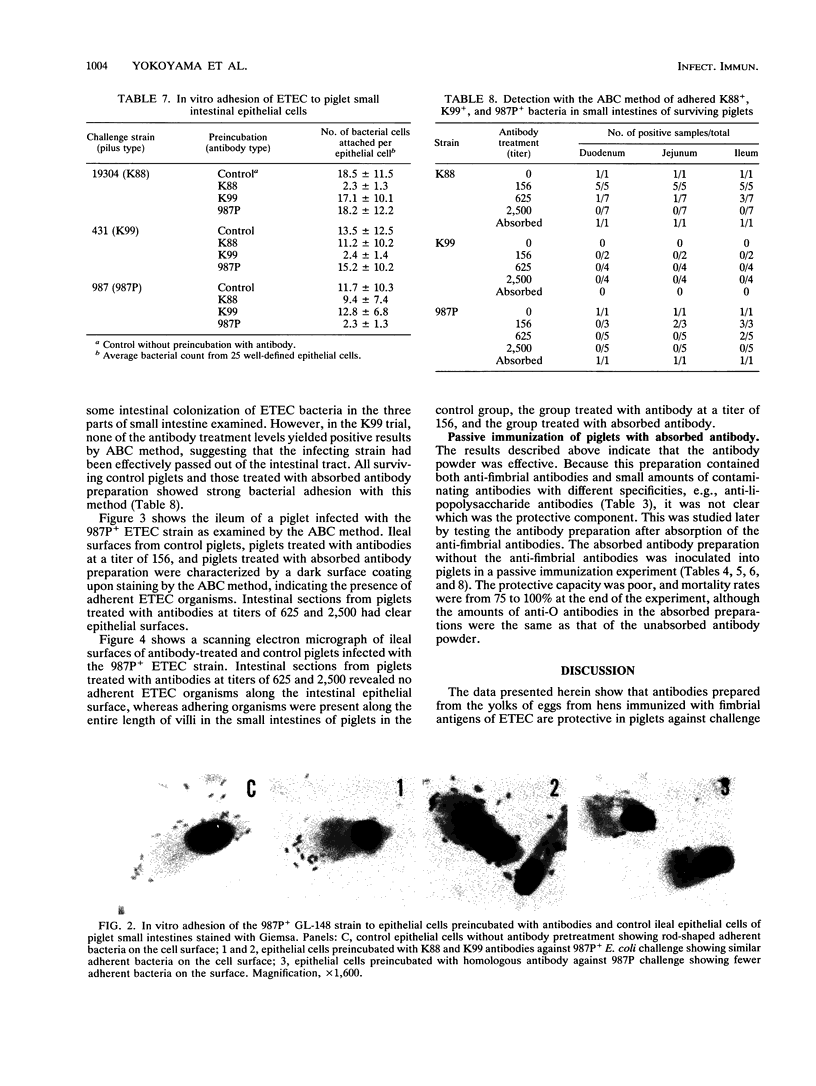
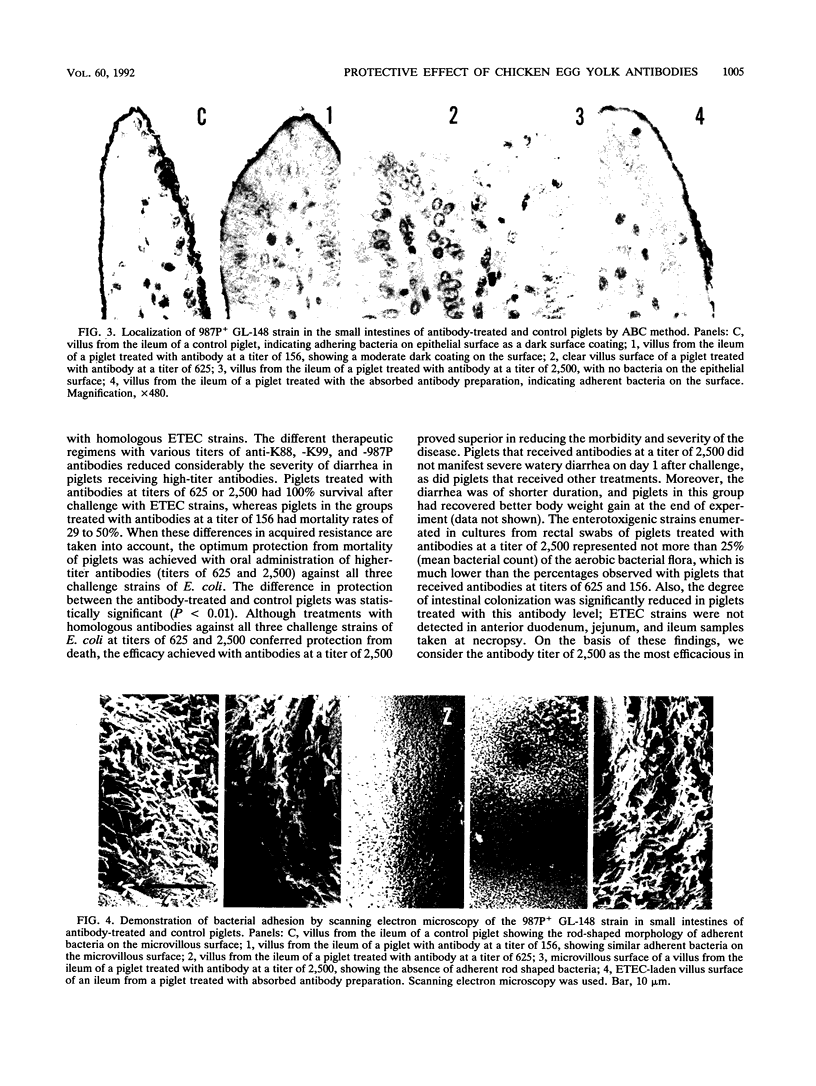
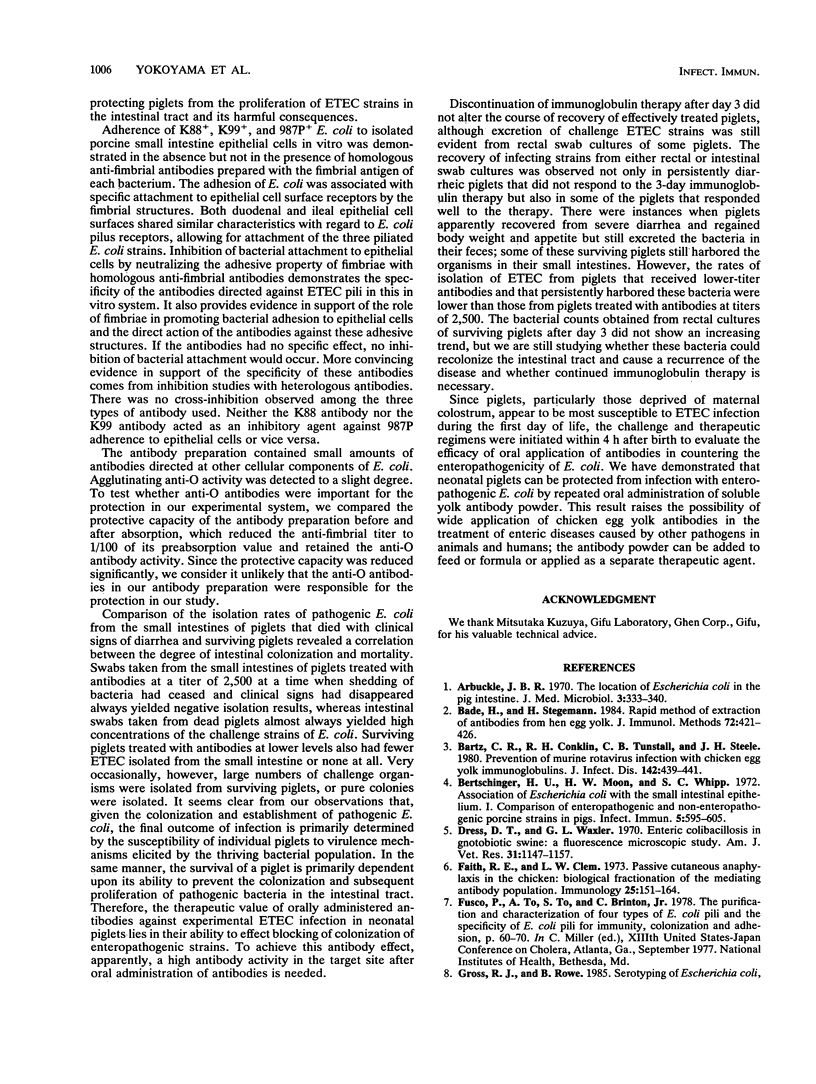

Images in this article
Selected References
These references are in PubMed. This may not be the complete list of references from this article.
- Arbuckle J. B. The location of Escherichia coli in the pig intestine. J Med Microbiol. 1970 May;3(2):333–340. doi: 10.1099/00222615-3-2-333. [DOI] [PubMed] [Google Scholar]
- Bade H., Stegemann H. Rapid method of extraction of antibodies from hen egg yolk. J Immunol Methods. 1984 Sep 4;72(2):421–426. doi: 10.1016/0022-1759(84)90010-3. [DOI] [PubMed] [Google Scholar]
- Bartz C. R., Conklin R. H., Tunstall C. B., Steele J. H. Prevention of murine rotavirus infection with chicken egg yolk immunoglobulins. J Infect Dis. 1980 Sep;142(3):439–441. doi: 10.1093/infdis/142.3.439. [DOI] [PubMed] [Google Scholar]
- Bertschinger H. U., Moon H. W., Whipp S. C. Association of Escherichia coli with the small intestinal epithelium. I. Comparison of enteropathogenic and nonenteropathogenic porcine strains in pigs. Infect Immun. 1972 Apr;5(4):595–605. doi: 10.1128/iai.5.4.595-605.1972. [DOI] [PMC free article] [PubMed] [Google Scholar]
- Drees D. T., Waxler D. L. Enteric colibacillosis in gnotobiotic swine: a fluorescence microscopic study. Am J Vet Res. 1970 Jul;31(7):1147–1157. [PubMed] [Google Scholar]
- Faith R. E., Clem L. W. Passive cutaneous anaphylaxis in the chicken. Biological fractionation of the mediating antibody population. Immunology. 1973 Jul;25(1):151–164. [PMC free article] [PubMed] [Google Scholar]
- Guinée P. A., Veldkamp J., Jansen W. H. Improved minca medium for the detection of K99 antigen in calf enterotoxigenic strains of Escherichia coli. Infect Immun. 1977 Feb;15(2):676–678. doi: 10.1128/iai.15.2.676-678.1977. [DOI] [PMC free article] [PubMed] [Google Scholar]
- Hiraga C., Kodama Y., Sugiyama T., Ichikawa Y. Prevention of human rotavirus infection with chicken egg yolk immunoglobulins containing rotavirus antibody in cat. Kansenshogaku Zasshi. 1990 Jan;64(1):118–123. doi: 10.11150/kansenshogakuzasshi1970.64.118. [DOI] [PubMed] [Google Scholar]
- Hsu S. M., Raine L., Fanger H. Use of avidin-biotin-peroxidase complex (ABC) in immunoperoxidase techniques: a comparison between ABC and unlabeled antibody (PAP) procedures. J Histochem Cytochem. 1981 Apr;29(4):577–580. doi: 10.1177/29.4.6166661. [DOI] [PubMed] [Google Scholar]
- Isaacson R. E., Richter P. Escherichia coli 987P pilus: purification and partial characterization. J Bacteriol. 1981 May;146(2):784–789. doi: 10.1128/jb.146.2.784-789.1981. [DOI] [PMC free article] [PubMed] [Google Scholar]
- Jensenius J. C., Andersen I., Hau J., Crone M., Koch C. Eggs: conveniently packaged antibodies. Methods for purification of yolk IgG. J Immunol Methods. 1981;46(1):63–68. doi: 10.1016/0022-1759(81)90333-1. [DOI] [PubMed] [Google Scholar]
- Klemm P. Fimbrial adhesions of Escherichia coli. Rev Infect Dis. 1985 May-Jun;7(3):321–340. doi: 10.1093/clinids/7.3.321. [DOI] [PubMed] [Google Scholar]
- Knutton S., Lloyd D. R., Candy D. C., McNeish A. S. Adhesion of enterotoxigenic Escherichia coli to human small intestinal enterocytes. Infect Immun. 1985 Jun;48(3):824–831. doi: 10.1128/iai.48.3.824-831.1985. [DOI] [PMC free article] [PubMed] [Google Scholar]
- Kuzuya M., Yokoyama H., Kodama Y. Purification of K88 and K99 pili from porcine enterotoxigenic Escherichia coli by affinity chromatography. Nihon Juigaku Zasshi. 1988 Aug;50(4):951–953. doi: 10.1292/jvms1939.50.951. [DOI] [PubMed] [Google Scholar]
- Kühlmann R., Wiedemann V., Schmidt P., Wanke R., Linckh E., Lösch U. Chicken egg antibodies for prophylaxis and therapy of infectious intestinal diseases. I. Immunization and antibody determination. Zentralbl Veterinarmed B. 1988 Oct;35(8):610–616. doi: 10.1111/j.1439-0450.1988.tb00535.x. [DOI] [PubMed] [Google Scholar]
- Laemmli U. K. Cleavage of structural proteins during the assembly of the head of bacteriophage T4. Nature. 1970 Aug 15;227(5259):680–685. doi: 10.1038/227680a0. [DOI] [PubMed] [Google Scholar]
- Mooi F. R., de Graaf F. K. Molecular biology of fimbriae of enterotoxigenic Escherichia coli. Curr Top Microbiol Immunol. 1985;118:119–138. doi: 10.1007/978-3-642-70586-1_7. [DOI] [PubMed] [Google Scholar]
- Polson A., Coetzer T., Kruger J., von Maltzahn E., van der Merwe K. J. Improvements in the isolation of IgY from the yolks of eggs laid by immunized hens. Immunol Invest. 1985 Aug;14(4):323–327. doi: 10.3109/08820138509022667. [DOI] [PubMed] [Google Scholar]
- Rutter J. M., Anderson J. C. Experimental neonatal diarrhoea caused by an enteropathogenic strain of Escherichia coli in piglets: a study of the disease and the effect of vaccinating the dam. J Med Microbiol. 1972 May;5(2):197–210. doi: 10.1099/00222615-5-2-197. [DOI] [PubMed] [Google Scholar]
- Sherman D. M., Acres S. D., Sadowski P. L., Springer J. A., Bray B., Raybould T. J., Muscoplat C. C. Protection of calves against fatal enteric colibacillosis by orally administered Escherichia coli K99-specific monoclonal antibody. Infect Immun. 1983 Nov;42(2):653–658. doi: 10.1128/iai.42.2.653-658.1983. [DOI] [PMC free article] [PubMed] [Google Scholar]
- Wilson M. R., Hohmann A. W. Immunity to Escherichia coli in pigs: adhesion of enteropathogenic Escherichia coli to isolated intestinal epithelial cells. Infect Immun. 1974 Oct;10(4):776–782. doi: 10.1128/iai.10.4.776-782.1974. [DOI] [PMC free article] [PubMed] [Google Scholar]
- Yamamoto H., Watanabe H., Sato G., Mikami T. [Identification of immunoglobulins in chicken eggs and their antibody activity]. Jpn J Vet Res. 1975 Oct;23(4):131–140. [PubMed] [Google Scholar]
- Yolken R. H., Leister F., Wee S. B., Miskuff R., Vonderfecht S. Antibodies to rotaviruses in chickens' eggs: a potential source of antiviral immunoglobulins suitable for human consumption. Pediatrics. 1988 Feb;81(2):291–295. [PubMed] [Google Scholar]





